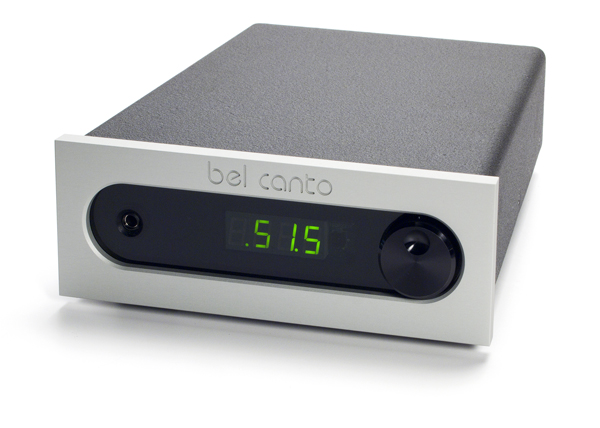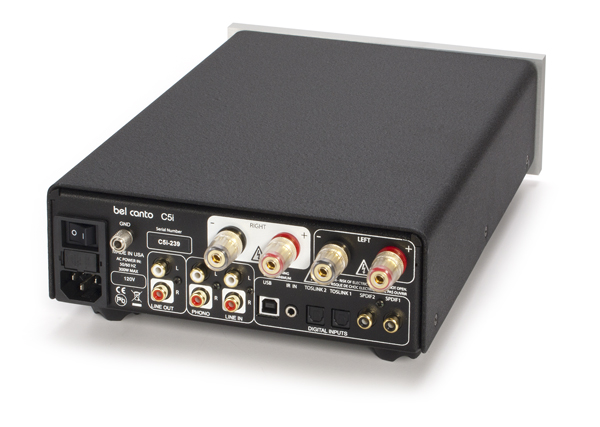 Many of my non-audiophile friends would love to have a great music system, but often ask the same question: “Do I really need that rack full of components?” With the Bel Canto C5i DAC Integrated Amplifier you don’t. For those who want a serious hi-fi system with a diminutive footprint, the C5i is the perfect place to begin. Add speakers, a source, and you are ready to rock.
Many of my non-audiophile friends would love to have a great music system, but often ask the same question: “Do I really need that rack full of components?” With the Bel Canto C5i DAC Integrated Amplifier you don’t. For those who want a serious hi-fi system with a diminutive footprint, the C5i is the perfect place to begin. Add speakers, a source, and you are ready to rock.
At $1,895 the C5i includes a 60-watt-per-channel class-D power amplifier, 24/192 DAC, MM phonostage, and a respectable headphone amplifier. Bel Canto skips the preamplifier stage, driving the amp directly from the DAC section, utilizing their 24-bit digital level control. Designer John Stronczer likes to point out that their approach leaves “no stinky pots to wear out.” The MM and line level inputs go through a 24/192 ADC into the DAC section, eliminating the traditional line level preamplifier function entirely. And it’s all neatly tucked into a box the size of a Stephen King novel. Thanks to the class -D amplifier, the C5i only draws about 13 watts from the outlet, so your carbon footprint won’t be taxed.
Fortunately 60wpc is also enough juice to entertain a wide range of speaker possibilities Most of my listening sessions took place with the new Dali F5 speakers with 88db sensitivity. Yet the C5i had no trouble when mated with the 83db Harbeth P3ESRs – perhaps due to the fact that it doubles its rated power into 4 ohms and can deliver up to 30 amps of peak current.
Along with losing the stack of gear and pile of cables required by a more traditional setup, you need just one interconnect pair to operate a system based on the C5i—another plus. With the C5i, your computer or laptop is only a USB cable away from becoming a first-class digital front end. In addition to the USB port, the unit boasts a pair of RCA SPDIF inputs as well as a pair of TOSLINK optical inputs. You can connect a cable TV box, game console, or whatever other digital device suits your fancy, turning the C5i into a media hub. The USB port offers digital playback up to 24/96, while the SPDIF and Toslink ports take full advantage of the DAC’s 24/192 capabilities.
In addition to the MM phono input with standard 47k ohm loading, a high-level analog input is available should you add another phonostage or perhaps, a tuner – like Bel Canto’s FM1. Using the phonostage with a handful of MM cartridges delivered excellent results. The Shure V15mvxr, Rega Exact, and Clearaudio Maestro Wood all worked well with the on-board phono, and I was also happy with the sound of my recent LP-12/V15 combo. Quiet, dynamic and musical, the on-board phonostage is equal to if not better than any of the sub-$300 external phonostages I’ve experienced.
The Rega RP1/Ortofon OM5e also effortlessly pairs with the C5i. Listening to a handful of budget 70s rock records revealed enough midrange warmth and depth to feel the analog love. Bottom line: If you don’t already have a turntable, the C5i makes adding analog to your system a painless process. True analog fanatics will want more performance, but they aren’t the model’s target audience.
Love digital? So does the C5i. High-resolution and 16/44.1 files via a Mac Mini, Sooloos Control 15, and MSB Universal Transport transmitted without a hiccup. When you push play and the music begins, the sampling rate blinks on the C5i’s main display. Since most of my high-res collection is at 24/96 I didn’t audition any 24/192 material.
The C5i’s DAC performance also impressed by holding its own with a number of competitors in the $500-$1,000 category. Listening to my fair share of the BBC’s Bax: The Symphonies box set, I couldn’t help but notice the DAC’s level of tonal purity and separation, even on 16/44.1 recordings. Should these options seem like too much work, the C5i works great with an iPod. Plugging in a little 4GB iPod Nano yields fab results, especially with Apple lossless files.
A prominent sonic wallop is likely the first thing you’ll notice when firing up the C5i. Bass is particularly well controlled, as is transient attack. The California Guitar Trio’s “Led Foot” demonstrates the C5i’s ability to maintain pace while simultaneously keeping separate and clean the three distinct guitar voices. California Guitar Trio records contain a wealth of musical information in a small space, an acoustic that most moderately priced integrated models fail at recreating.
Bill Bruford’s Earthworks lies at the opposite end of the sound spectrum. A skilled drummer that never hesitates to maximize his kit, Bruford provides a great torture test. The C5i has no problem keeping the cymbals in their own distinct space as the percussionist takes flight on several rapidly paced solos.
Comparing the C5i to the much larger REF500M monoblocks reveals a close resemblance at less-than-earthquake levels, and for good reason: The C5i uses the same power modules, albeit in stereo rather than in a bridged mono configuration. Again, Bel Canto doesn’t sacrifice sound quality at a lower power level, making the C5i an even more attractive proposition regardless of where you sit in the audiophile pecking order. And diversity abounds.
The high-level outputs give it even more versatility for listeners that desire a satellite/subwoofer system. Users that either don’t want or can’t get speakers right now should think of the C5i as a wonderful headphone amp that happens to have a great DAC and phonostage. It adequately drove the new Grado PS500, Audeze LCD2, AKG 701, and Sennheiser 650 headphones. Yes, you can drop another $500-$1,000 on an outboard headphone amp, but this one works well and is miles beyond any pod or tablet.
New Balance
As much fun as it is to listen to the C5i, its seamless integration into any environment means there’s no reason not to have a great hi-fi in your house. You don’t need a pile of gear, massive loom of cables, or gaggle of remote controls. If you’d like to build a system a few marks above the budget level, the C5i awaits your discovery. It combines both functionality and performance in a compact package, underscoring the fact that you don’t need to spend a small fortune to get good sound. More, please.





















